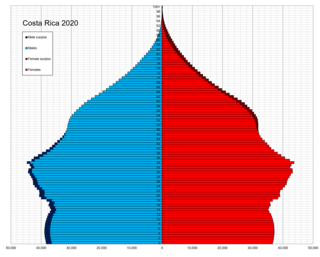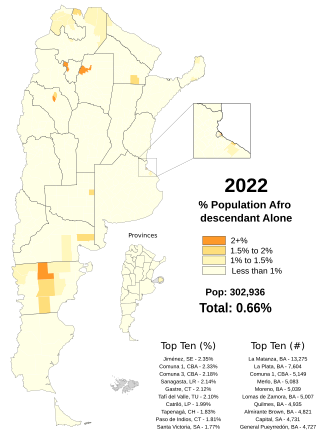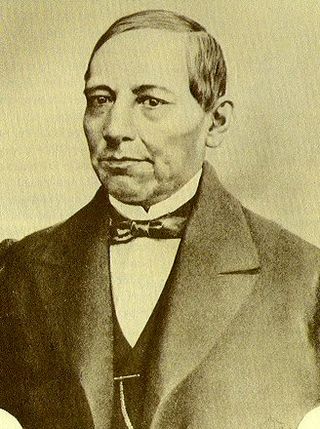
This is a demographic article about Costa Rica's population, including population density, ethnicity, education level, health of the populace, economic status, religious affiliations, and other aspects of the population.

This is a demography of Argentina including population density, ethnicity, economic status and other aspects of the population.

The globalAfrican diaspora is the worldwide collection of communities descended from people from Africa, predominantly in the Americas. The African populations in the Americas are descended from haplogroup L genetic groups of native Africans. The term most commonly refers to the descendants of the native West and Central Africans who were enslaved and shipped to the Americas via the Atlantic slave trade between the 16th and 19th centuries, with their largest populations in the United States, Brazil, and Haiti. However, the term can also be used to refer to African descendants who immigrated to other parts of the world consensually. Some scholars identify "four circulatory phases" of this migration out of Africa. The phrase African diaspora gradually entered common usage at the turn of the 21st century. The term diaspora originates from the Greek διασπορά which gained popularity in English in reference to the Jewish diaspora before being more broadly applied to other populations.
Afro–Latin Americans or Black Latin Americans are Latin Americans of full or mainly sub-Saharan African ancestry.
Latin Americans are the citizens of Latin American countries.
Afro-Caribbean people or African Caribbean are Caribbean people who trace their full or partial ancestry to Africa. The majority of the modern Afro-Caribbean people descend from the Africans taken as slaves to colonial Caribbean via the trans-Atlantic slave trade between the 15th and 19th centuries to work primarily on various sugar plantations and in domestic households. Other names for the ethnic group include Black Caribbean, Afro or Black West Indian or Afro or Black Antillean. The term Afro-Caribbean was not coined by Caribbean people themselves but was first used by European Americans in the late 1960s.

The Indigenous peoples of South America or South American Indigenous peoples, are the pre-Columbian peoples of South America and their descendants. These peoples contrast with South Americans of European ancestry and those of African descent.
White Latin Americans or European Latin Americans are Latin Americans of European descent.

Afro-Colombians or African-Colombians are Colombians of full or partial sub-Saharan African descent.

Afro-Argentines are Argentines of primarily Sub-Saharan African descent. The Afro-Argentine population is the result of people being brought over during the transatlantic slave trade during the centuries of Spanish domination in the region and immigration from Africa.
Marlon is a masculine given name. According to the Oxford Dictionary of First Names, the popularity of Marlon Brando led to general awareness of the name, though the origin of the name is not known. Speculation places the name's origin in France as a derivative of Marc.

European emigration is the successive emigration waves from the European continent to other continents. The origins of the various European diasporas can be traced to the people who left the European nation states or stateless ethnic communities on the European continent.

Afro-Uruguayans are Uruguayans of predominantly African descent. The majority of Afro-Uruguayans are in Montevideo.

Afro-Chileans are Chilean people of African descent. They may be descendants of slaves who were brought to Chile via the trans-Atlantic slave trade, or recent migrants from other parts of Latin America, the Caribbean or Africa.

The demographics of Colombia consist of statistics regarding Colombians' health, economic status, religious affiliations, ethnicity, population density, and other aspects of the population. Colombia is the second-most populous country in South America after Brazil, and the third-most populous in Latin America, after Brazil and Mexico.

Argentines are the people identified with the country of Argentina. This connection may be residential, legal, historical or cultural. For most Argentines, several of these connections exist and are collectively the source of their being Argentine. In the past the National Gentilic for Citizens of Argentina was mistakenly translated as Argentinians, a term that is no longer considered accurate.

The inhabitants of Latin America are from a variety of ancestries, ethnic groups and races, making the region one of the most diverse in the world. The specific composition of the group varies from country to country. Many have a predominance of European-Amerindian or Mestizo population; in others, Amerindians are a majority; some are dominated by inhabitants of European ancestry; and some countries' populations have large African or Mulatto populations.
Afro-Spaniards are Spanish people of African descent namely Black or Black of mixed ancestry. The term may include Spaniards of any African background who are considered to be Black or of Black mixed ancestry mainly those of Afro-Caribbean, African American or Afro Latin American descent. The specific number of Afro-Spaniards is unknown due to the fact that the Spanish government does not collect data on ethnicity or racial self-identification.
Race and ethnicity in Colombia descend mainly from three racial groups—Europeans, Amerindians, and Africans—that have mixed throughout the last 500 years of the country's history. Some demographers describe Colombia as one of the most ethnically diverse countries in the Western Hemisphere and in the World, with 900 different ethnic groups. Most Colombians identify themselves and others according to ancestry, physical appearance, and sociocultural status. Social relations reflect the importance attached to certain characteristics associated with a given racial group. Although these characteristics no longer accurately differentiate social categories, they still contribute to one's rank in the social hierarchy. A study from Rojas et al involving 15 departments determined that the average Colombian has a mixture of 47% Amerindian 42% European, and 11% African. These proportions also vary widely among ethnicities.












